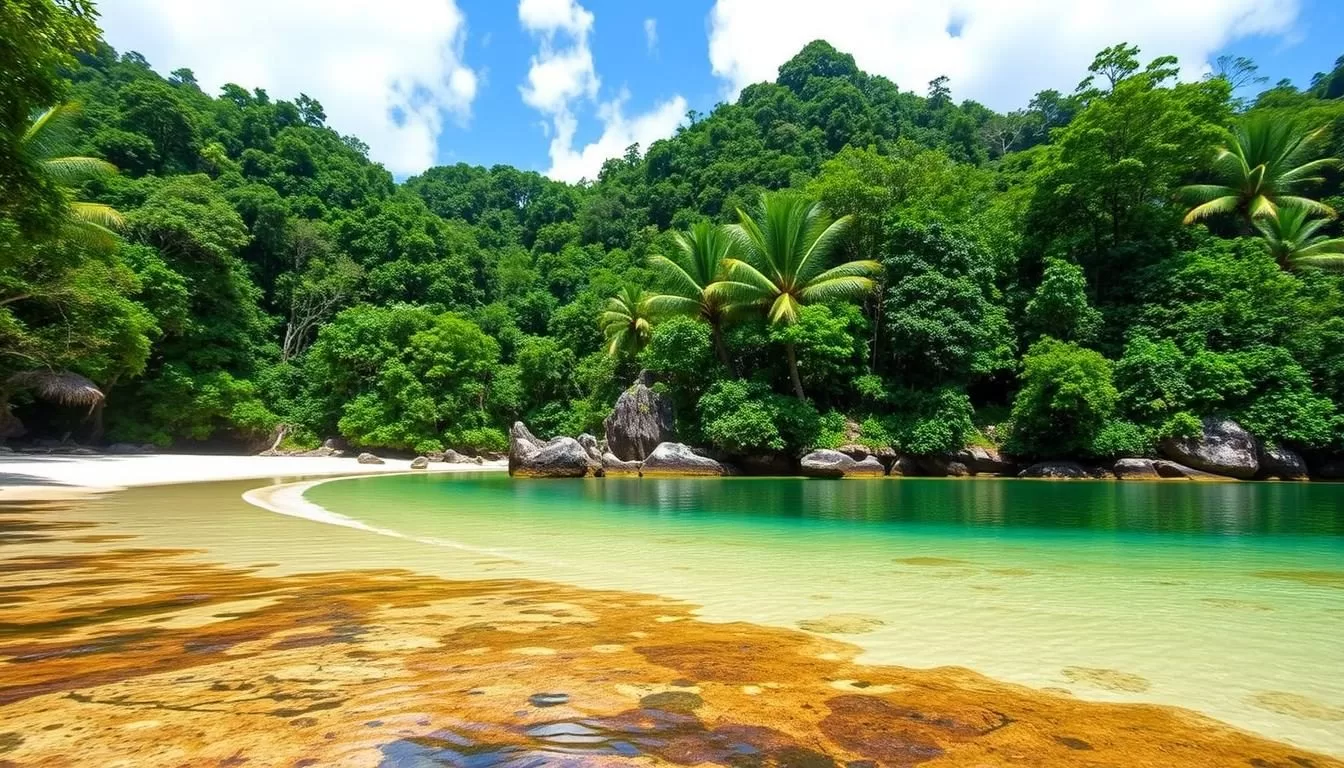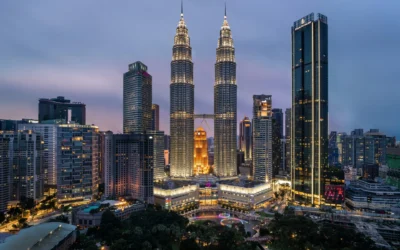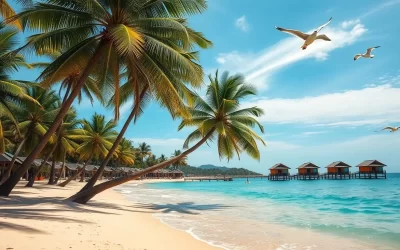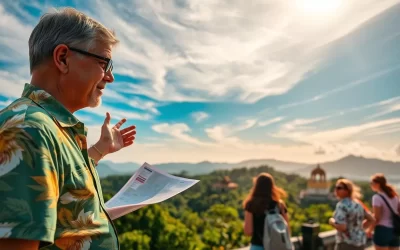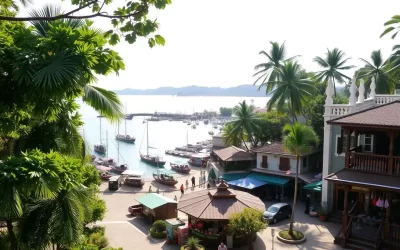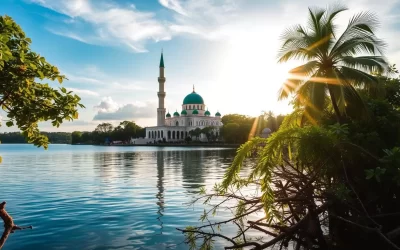Discover the hidden gem of Southeast Asia at Tiga Island National Park, one of Malaysia’s most captivating natural treasures. Located in the heart of Southeast Asia, this volcanic island, formed in 1897, offers a unique combination of pristine beaches, bubbling mud volcanoes, and lush rainforests that make it a must-visit destination.
Known as “Survivor Island” after hosting the reality TV show, Tiga Island provides visitors with numerous activities ranging from hiking and snorkeling to mud volcano experiences. You’ll discover why this hidden gem has become increasingly popular among nature enthusiasts and adventure seekers looking for authentic Malaysian experiences.
This comprehensive guide will walk you through the top things to do on Tiga Island, helping you plan an unforgettable journey to this natural paradise. Whether you’re interested in exploring the island’s volcanic origins, relaxing on its pristine beaches, or engaging in various adventure activities, Tiga Island National Park has something for everyone.
As you plan your trip, you’ll find that Tiga Island National Park is a destination that promises an enriching experience, blending adventure, nature, and relaxation in the beautiful setting of Southeast Asia.
Discovering the Natural Paradise of Tiga Island National Park
As you step into the serene environment of Tiga Island National Park, you’ll discover a world unlike anywhere else. This natural paradise is a must-visit destination for any traveler.
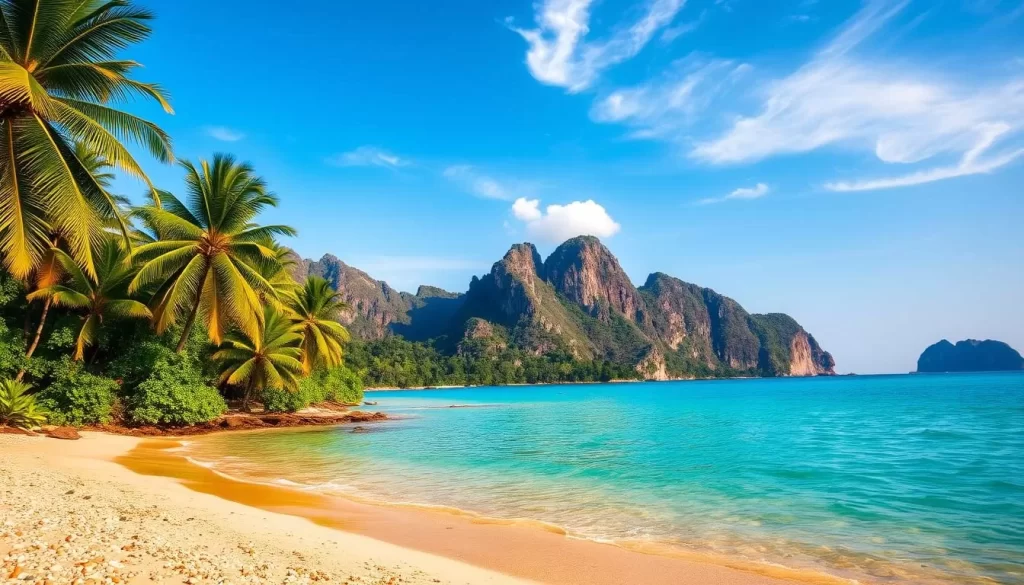
Location and Background of Tiga Island
Tiga Island National Park is situated off the western coast of Sabah in Malaysian Borneo. The island is accessible by boat from Kota Kinabalu, making it a perfect addition to your travel itinerary. The island has a unique history, having emerged from the sea following a volcanic eruption in 1897. This event created a unique ecosystem that’s now home to diverse wildlife and geological wonders unlike anywhere else in the country.
When to Visit and What to Expect
The best time to visit Tiga Island National Park is during the dry season, between March and October. During this period, you can enjoy clear skies and calm waters, making it ideal for beach activities and hiking. The island offers basic facilities, including a canteen serving local Malaysian food. However, it’s recommended to bring your own supplies for a full-day excursion. This comprehensive guide will help you navigate the island’s attractions, whether you’re planning a day trip or an overnight stay at the park’s rustic accommodations.
Hiking Through Pristine Rainforest Trails
As you step into Tiga Island National Park, the lush rainforest beckons you to explore its untouched trails. The national park offers a unique hiking experience, with trails that wind through pristine rainforests, providing experiences suitable for both beginners and experienced hikers.
Popular Hiking Routes for All Levels
Tiga Island National Park has several well-maintained hiking trails. The Mud Volcano Trail is a moderate 2.5km trek that takes you through diverse ecosystems before reaching the famous bubbling mud pools. For those seeking more challenging adventures, the Peak Trail leads to the island’s highest point at 330m, rewarding you with panoramic views that rival those in Kuala Lumpur‘s skyline viewpoints but with natural beauty untouched by urban development.
Wildlife Spotting Opportunities
Wildlife enthusiasts will appreciate the Early Morning Trail, where you can spot monitor lizards, flying foxes, and numerous bird species that are active at dawn – making it one of the essential things to do for nature lovers. Unlike the crowded nature parks near Kuala Lumpur, Tiga Island’s trails offer a more secluded experience, allowing you to connect with nature without the distraction of large tourist groups. This is truly one of the many things to enjoy in this national park, which is part of Malaysia’s rich national park heritage.
Exploring the Famous Mud Volcanoes
The mud volcanoes of Tiga Island National Park offer a one-of-a-kind experience, blending natural beauty and unique geological processes. As one of the park’s main attractions, these mud volcanoes are a must-visit for anyone traveling to the island.
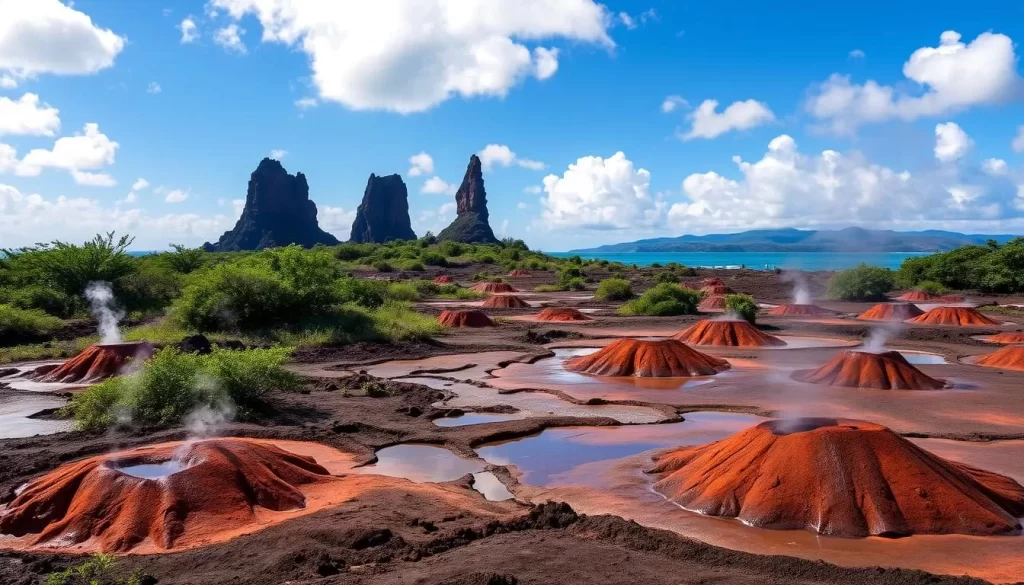
The Science Behind Tiga’s Mud Volcanoes
The mud volcanoes are formed when gases from deep within the earth push through clay-rich sediments, creating bubbling pools of mineral-rich mud. This process not only shapes the landscape but also creates a unique environment that is believed to have therapeutic properties for your skin. The area surrounding the mud volcanoes is a testament to the raw beauty of natural geological processes.
| Feature | Description |
|---|---|
| Mud Composition | Mineral-rich, believed to have therapeutic properties |
| Formation Process | Gases pushing through clay-rich sediments |
| Surrounding Landscape | Lunar-like, showcasing raw natural beauty |
Tips for a Safe and Fun Mud Volcano Experience
To make the most of your visit to the mud volcanoes in Tiga Island National Park, it’s essential to follow some guidelines. Always follow the marked paths and wear appropriate footwear to ensure your safety. The mud can stain clothing permanently, so it’s recommended to wear dark swimwear and bring a change of clothes. Additionally, be mindful of the wildlife that gathers near the smaller mud pools, especially at dawn and dusk, offering a rare opportunity to observe native species in their natural habitat.
Visiting the mud volcanoes is an experience that combines adventure with the appreciation of natural park landscapes and wildlife. While enjoying this unique feature, remember to respect the environment to preserve its beauty for future visitors. The mud volcanoes are undoubtedly a highlight of any trip to Tiga Island, located near beautiful beaches that are worth exploring.
Snorkeling in Crystal Clear Waters
The waters surrounding Tiga Island are a snorkeler’s paradise, teeming with life and color. As you explore the underwater world, you’ll discover an array of marine life that calls this ecosystem home. The island’s rainforests and surrounding waters create a unique environment where the forest meets the sea, supporting a diverse range of species.
Snorkeling here is an experience open to all ages and skill levels, thanks to the generally calm and clear waters. Whether you’re a seasoned snorkeler or just starting out, Tiga Island has something to offer.
Best Snorkeling Spots Around the Island
Tiga Island is surrounded by crystal-clear waters that offer some of the best snorkeling experiences in Malaysian Borneo. The visibility often extends beyond 20 meters, making it ideal for spotting marine life.
- The South Bay coral gardens are perfect for first-time snorkelers, with shallow waters and gentle currents that provide a glimpse into the vibrant marine ecosystem.
- For more experienced snorkelers, the Eastern Point offers deeper waters where the rainforest seems to meet the sea, creating a unique underwater landscape.
- The best time for snorkeling is during the morning hours when the water is calmest and the marine life is most active.
Marine Life You Can Encounter
As you snorkel around Tiga Island, you’ll have the opportunity to see a variety of marine life. The underwater forest of coral and sea plants makes marine creatures easy to spot, offering a different perspective on the island’s biodiversity.
The diverse marine communities supported by the rainforests runoff nutrients provide a rich tapestry of life beneath the waves. From colorful fish to coral reefs, the marine life here is as vibrant as it is diverse.
Bird Watching in a Tropical Paradise
With its lush forests and diverse ecosystems, Tiga Island National Park is a paradise for those who love bird watching. The park has become a sanctuary for birdwatchers, offering the chance to spot over 40 species of birds in a relatively small place, making it one of the most concentrated bird-watching spots in the region.
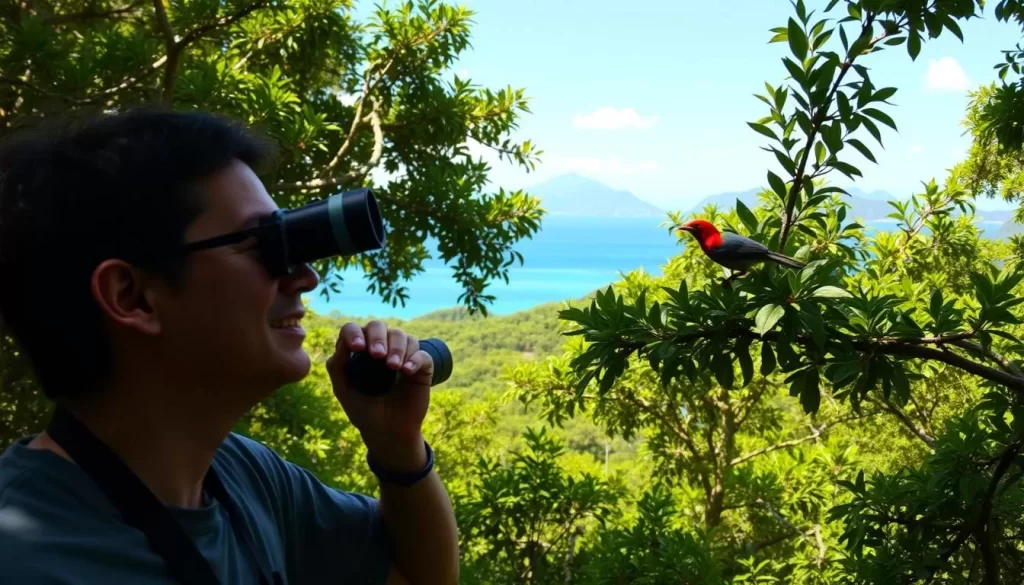
Endemic Bird Species to Look For
The island’s unique position as a relatively young landmass has created an interesting phenomenon where birds from surrounding islands have colonized it, resulting in a diverse avian population. Some of the endemic bird species you can look out for include megapodes (scrubfowl), hornbills, and sea eagles – species that are rarely seen together in other locations.
- Megapodes (scrubfowl)
- Hornbills
- Sea eagles
Best Locations and Times for Bird Watching
Early morning hours near the forest canopy viewing platforms provide views of the aforementioned species. The area near the ranger station, which features a small educational display similar to the cultural exhibits found at Malaysian temples, offers convenient bird watching opportunities. Between bird watching sessions, you can enjoy snorkeling breaks at nearby coves, creating a perfect balance of land and sea activities during your visit.
Tiga Island National Park, Malaysia: Best Things to Do for Adventure Seekers
Adventure seekers will find their paradise in Tiga Island National Park, Malaysia, with its vast array of thrilling activities. The park is a treasure trove of experiences that cater to the most daring adventurers.
Jungle Trekking Adventures
The jungle trekking adventures on Tiga Island take you deep into untouched forests where you might encounter monkeys swinging through the canopy or monitor lizards crossing your path. The park rangers offer guided experiences that ensure safety while maximizing your chances of memorable wildlife encounters.
As you trek through the dense rainforest, the sounds of the jungle envelop you, creating an immersive experience. The lush greenery and the vibrant flora make the trek a visually stunning journey.
Kayaking Around the Island
Kayaking around the island provides a unique perspective of the coastline, allowing you to access hidden coves and beaches while paddling through calm waters that reflect the lush greenery of the shoreline. This activity gives you a chance to witness the island’s diverse ecosystems up close.
For the ultimate adventure, combine an overnight jungle camp with early morning wildlife observation to experience the full cycle of jungle life, from the daytime activity to the mysterious sounds of the nocturnal forest.
The park’s attractions are not limited to its natural beauty; the adventure activities like kayaking offer a thrilling way to explore the island’s periphery.
Relaxing on Pristine Beaches
Tiga Island National Park is a haven for those seeking tranquility on its pristine beaches. The island boasts several secluded beaches that offer a serene paradise away from the crowds found on more developed Malaysian islands.
Top Beach Spots for Swimming and Sunbathing
Golden Beach on the eastern shore is a favorite among visitors, providing gentle waves and soft sand that slopes gradually into the crystal-clear sea. It’s perfect for swimming and sunbathing. Sunset Beach on the western side is ideal for those who want to enjoy spectacular evening views, although it’s less suitable for swimming due to stronger currents. For diving enthusiasts, the waters off South Point Beach offer glimpses of colorful coral formations and marine life.
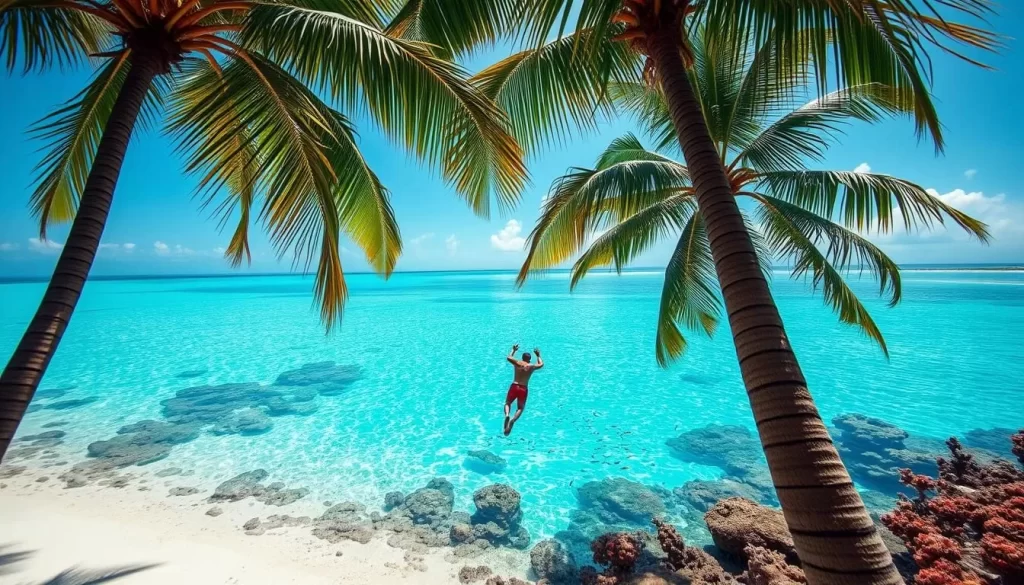
Beach Safety and Facilities
The park maintains basic facilities at the main beaches, including freshwater showers, changing rooms, and picnic areas. However, you should bring your own beach essentials as there are no rental services or organized tours within the park itself. When visiting the various spots around the island, be mindful of the local conditions and any safety advisories.
Visiting the Survivor Island Film Locations
Tiga Island’s fame extends beyond its natural beauty, as it was the filming location for the first season of ‘Survivor’ in 2000. This reality TV show transformed the island into a bucket-list destination for fans worldwide. The island’s diverse landscapes, including dense forests and dramatic mud volcanoes, made it an ideal backdrop for the show.
The History of Survivor on Tiga Island
The production team chose Tiga Island for its remote feel and diverse landscapes, which provided a compact yet varied setting for filming. The island’s forests and beaches were used for various challenges and tribal councils. You can learn more about the production at the ranger station, which features a small exhibit with photographs and information about the show.
How to Find the Famous Filming Spots
Visitors can take a guided tour to explore the key filming locations, including the Tribal Council area and challenge sites. Most visitors come on a day trip from Kota Kinabalu city. The trip typically departs early in the morning and returns late in the afternoon, giving you ample time to see the major ‘Survivor’ landmarks.
| Filming Location | Description |
|---|---|
| Tribal Council Area | Where contestants gathered to vote out their peers |
| Challenge Sites | Locations for physical and mental challenges |
| Camp Locations | Where contestants lived during their time on the island |
Where to Stay and Dining Options
For a comfortable and enjoyable trip to Tiga Island, understanding your accommodation and dining choices is crucial. The island offers a unique experience, with its natural beauty and limited but authentic amenities.
Accommodation Choices on and Near the Island
Accommodation options on Tiga Island are limited but authentic. The park offers basic hostel-style lodging and camping facilities for those who want to immerse themselves in the island’s natural beauty after the day-trippers have departed. For more comfortable stays, most visitors choose to base themselves in Kota Kinabalu and visit the island as a day excursion. The city offers numerous hotels ranging from budget to luxury, catering to various preferences and needs.
- Basic hostel-style lodging on the island
- Camping facilities for a more immersive experience
- Varied hotel options in Kota Kinabalu
Local Cuisine and Dining Experiences
The island’s canteen serves simple Malaysian meals, focusing on seafood and rice dishes. This provides a taste of local cuisine in a no-frills setting with spectacular ocean views. Visitors can also experience the vibrant street food scene in Kota Kinabalu before or after their island adventure. While Tiga Island doesn’t offer extensive dining options like the Perhentian Islands or near UNESCO World Heritage sites, its limited choices focus on fresh, local ingredients, providing an authentic taste of Sabahan cuisine.
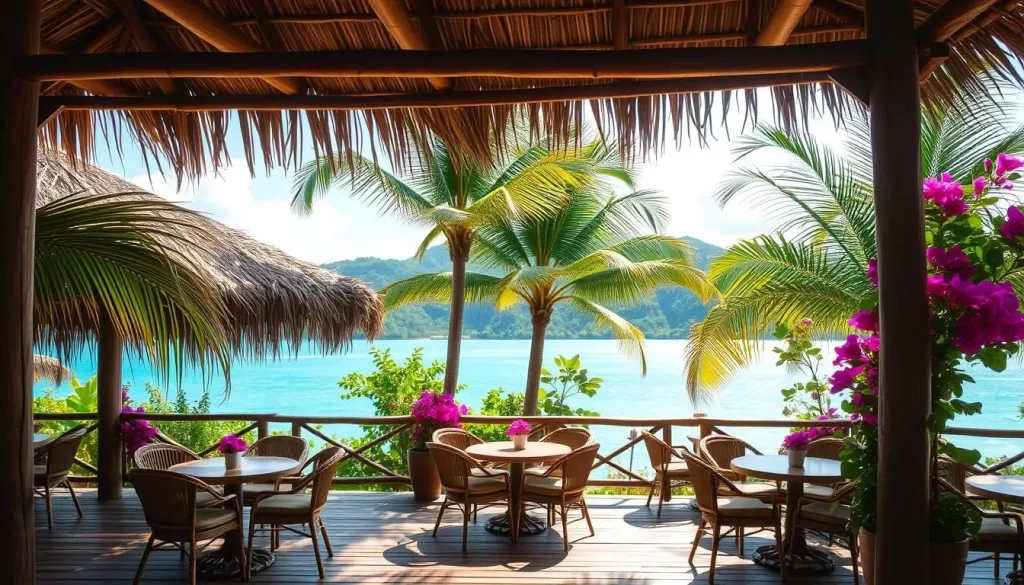
Practical Tips for Visiting Tiga Island National Park
To make the most of your visit to Tiga Island National Park, it’s essential to be well-prepared. This involves understanding how to get to the island, what to pack, and how to respect the park’s conservation efforts.
Getting to the Island
Reaching Tiga Island requires a boat journey from Kota Kinabalu. You can catch the service from Jesselton Point Ferry Terminal. It’s crucial to book in advance as the park authorities limit the number of daily visitors to preserve the island’s natural beauty. The journey takes about 1-1.5 hours, depending on sea conditions, so it’s a good idea to check the weather forecast beforehand.
- Boat services depart from Jesselton Point Ferry Terminal.
- Advance booking is essential due to limited daily visitors.
What to Pack for Your Trip
Packing the right items is vital for a comfortable and safe trip. Essentials include sunscreen, insect repellent, hiking shoes, swimwear, a change of clothes, water bottles, and a small first aid kit. These items will ensure you’re prepared for the various activities the park offers.
Conservation and Responsible Tourism
Tiga Island operates under strict conservation guidelines, similar to UNESCO World Heritage sites. To preserve its beauty, refrain from removing natural items, feeding wildlife, or leaving trash behind. By staying on marked trails, minimizing plastic use, and respecting wildlife, you contribute significantly to the park’s protection efforts.
Conclusion
Tiga Island National Park stands out as a premier destination in Malaysia, boasting a mix of volcanic wonders, rainforest hikes, and serene beaches. This national park is a true gem, offering a unique blend of adventure and relaxation that caters to diverse interests and preferences.
Your time on the island can be as adventurous or relaxing as you choose, with activities ranging from challenging rainforest hikes to peaceful days on secluded beaches. The island’s wildlife viewing opportunities, both in its forests and surrounding waters, provide unforgettable experiences that rival those found in Malaysia’s larger national parks.
Whether you’re visiting as a day trip from Kota Kinabalu or staying overnight to fully immerse yourself in island life, Tiga Island offers a glimpse into a world where nature still reigns supreme, far from the developed tourist spots of the Perhentian Islands. As you leave this paradise, you’ll take home memories of snorkeling in crystal-clear sea waters, encounters with curious monkeys, and the peaceful feeling that comes from spending time in one of the most beautiful natural places in the country.
This comprehensive guide has shown you the best things to do in Tiga Island National Park, but the true magic of this special place comes from the unexpected moments and personal discoveries you’ll make as you explore its diverse attractions and landscapes.
The above is subject to change.
Check back often to TRAVEL.COM for the latest travel tips and deals.
